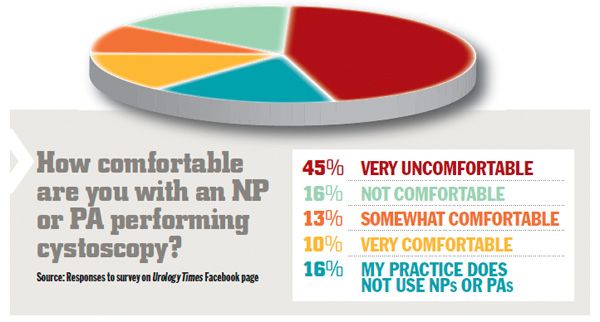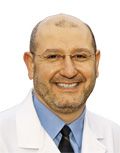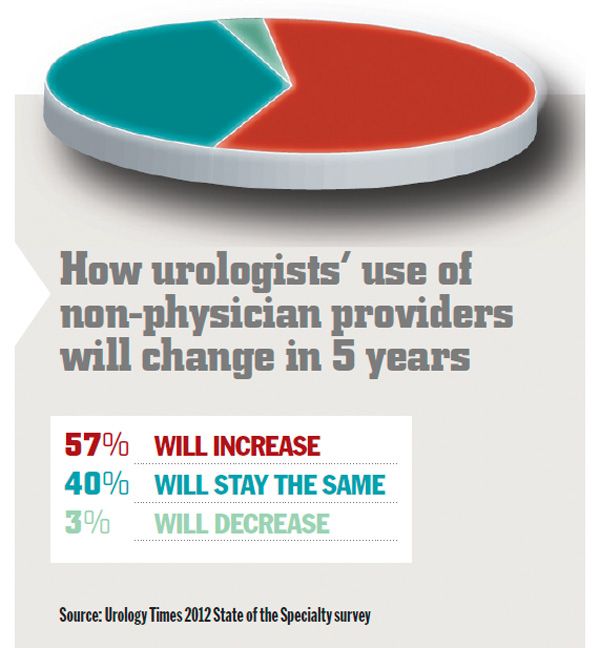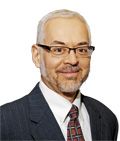Article
Non-physician providers: Allied or disparate?
The urology work force shortage has created a demand for non-physician providers such as nurse practitioners and physician assistants, but the scope of what these allied health professionals can do remains a matter of debate.
Urologist Muta M. Issa, MD, MBA, says the writing is on the wall: Urologists need to restructure and realign the urology work force to meet increasing patient demand amid a projected urologist shortage.
Allied health professionals play an increasingly important role in the urology work force, he says. Dr. Issa is among the proponents in the profession who advocates arming these providers-in his case, physician assistants (PAs)-with what they need to perform even advanced diagnostic procedures such as flexible cystoscopy.
Urologists, however, are far from universally embracing the change. When Urology Times posed the question on its Facebook page, “How comfortable are you with having a nurse practitioner or physician assistant perform a cystoscopy on one of your patients?” nearly half (45%) said they were “very uncomfortable,” and only 10% reported being “very comfortable.”

“They are just not qualified to do procedures,” said Suresh Sidh, MD, in a Facebook post.
The experience of Emory University School of Medicine in Atlanta has shown otherwise, says Dr. Issa, professor of urology at Emory.

Dr. Issa“Over a 10-year period, we set up a program to train physician assistants to perform outpatient diagnostic outpatient procedures, such as prostate ultrasound and biopsy and flexible diagnostic cystoscopy,” he said. “Of the 400 to 500 prostate biopsy procedures performed annually at our department of urology, the majority (70% to 80%) are currently performed by our four physician assistants.”
Why delegate such controversial responsibilities to PAs? According to Dr. Issa, it just makes sense.
“The two procedures [ultrasound-guided biopsy and cystoscopy] are repetitive and mechanical, making them relatively straightforward to learn and be proficient at. They are performed in high volumes and therefore tend to take up a good portion of the urologist’s time and effort. By training PAs to do these two procedures, the urologist would have more flexibility for cross-coverage, as well as ensure full utilization of the PAs’ time,” he said.
The quality of training is key to the collaboration’s success, according to Dr. Issa. Emory’s training program for prostate ultrasound and biopsy, for example, features well-structured didactics and hands-on training. It involves urologists’ monitoring and supervising the first 50 cases and, beyond that, periodically evaluating PAs’ work for outcomes, including positive biopsy and adverse event rates, local anesthetic adequacy, and patient satisfaction.
“In our medical facility, we have fully integrated endourology suites with the capability of remote monitoring and supervision as well as instant feedback through live communication. This allows for superb training where queries or issues can be addressed immediately,” Dr. Issa said.

The training program has led to good results, according to Dr. Issa. Internal monitoring of the program confirms PAs perform the procedures efficaciously, safely, and cost-effectively. The average manpower cost for a PA to perform a prostate ultrasound and biopsy is 30% of that of a urologist, based on a salary differential of 3:1. The reimbursement is 90%, he says.
Quality in the hands of PAs is the same or better than urologist benchmarks, according to Dr. Issa.
“We have one of the lowest rates of infections in the world. So, our numbers really speak for themselves,” he said.
PAs and nurse practitioners (NPs) also have good quality track records in cystoscopy, according to Barry A. Kogan, MD, professor of surgery and pediatrics and chief of the division of urology at Albany Medical College, Albany, NY.

Dr. Kogan“The literature suggests that they can perform the procedure safely and effectively. The only concern is that they may err on the side of not making a mistake. If they find a lesion on office cystoscopy, it needs to be followed by a procedure under general anesthesia. Some studies have shown a higher rate of false-negative procedures under general anesthesia when comparing nurse specialists to urologists,” Dr. Kogan said.
Heather Schultz, NP, clinical instructor in urology at the University of North Carolina at Chapel Hill, says most of the data on NP and PA outcomes in urology are from the United Kingdom.

Heather Schultz, NP“We need to work on our own outcomes data here in the U.S. on cystoscopy, but the UK has this research. They have NP-run bladder cancer surveillance clinics and have experience with cystoscopy, where efficacy has been documented for the last 20 years,” Schultz said, citing studies by Fagerberg (Lakartidningen 2005; 102:2149-50), Gidlow BJU Int 2000; 85:651-4), and Radhakrishnan (BJU Int 2006; 98:256-8).
While conducting head-to-head comparison studies of diagnostic procedures among physicians and NPs is not realistic, the lengthy UK experience with NPs has been positive, says Neil Burgess, MCh, consultant urologist at Norfolk and Norwich University Hospital in Norwich, UK.
“I don’t think there’s a problem with it at all. Where I’ve seen nurses do things in place of the doctor, they do it better, in my opinion, because they stick to protocol and they don’t take shortcuts,” he said.
Allied health professionals have plenty to do at urology practices, even if they don’t perform advanced diagnostic procedures, according to Kenneth Mitchell, MPAS, PA-C, immediate past president of the Urological Association of Physician Assistants (UAPA). Mitchell, who works at Metro Urology in Woodbury, MN, specializes in male sexual dysfunction.
“In our group, … we have some PAs that perform all inpatient duties. We have someone who does female urology. We have one individual who does stone management,” Mitchell said.
A fuzzy snapshot
It’s not clear just how many urology practices have PAs and NPs, or how many allow these individuals to perform advanced diagnostic procedures. In April 2011, the AUA surveyed 678 affiliate members, including NPs, PAs, nurses, clinical nurse specialists, and surgical technicians. Of the 205 who responded, 51% were NPs and 37% PAs. Just over one-third (36%) of PAs and 8% of NPs indicated they performed cystoscopy, while 16% of PAs and 4% of NPs said they did prostate biopsy.
A more recent survey conducted by Diane Newman, DNP, CRNP, and Alan Wein, MD, of the University of Pennsylvania, Philadelphia was sent to 5,250 urologists with two e-mail requests from UroToday. A total of 527 urologists responded, with 255 indicating they have at least one NP or PA in their practice, as reported at the 2012 Society of Urologic Nurses and Associates (SUNA) annual meeting. Of those urologists who do employ NPs or PAs, 134 (53%) have these providers perform cystoscopies and the majority directly supervise the procedure. Responses concerning prostate biopsy indicate that 19.2% use an NP or PA to perform this procedure, and all are performed under direct supervision.
What is clearer is membership at urology-specific NP and PA membership organizations is growing, though numbers within the specialty remain relatively small.
Professional urology associations for NPs and PAs report rising but still relatively small numbers in the profession. The UAPA estimates there are about 3,000 to 4,000 PAs working in urology, Mitchell says. That’s out of 83,000 or more PAs in the country. UAPA membership has risen from 135 members in 2012 to 224 as of June 2013.
The growth of allied health providers in urology is out of need, according to Mitchell.
The AUA in 2008 formed a committee that looked at how it would address the work force shortage, and one of its recommendations was to increase usage of NPs and PAs, he said.
Who makes the call?
An NP’s or PA’s scope of practice is dictated by state laws and regulations, as well as by supervising physicians, according to Dr. Kogan. In most states, NPs are governed by nursing boards and can practice independently, whereas PAs are most often governed under the same board as physicians and must practice under physicians, he says.
Scope-of-practice laws vary from state to state. The push in some state legislatures to expand scope of practice among non-physician providers has intensified in the past year, with Nevada becoming the 17th state (plus the District of Columbia) to offer patients full and direct access to NP services. Nursing groups in 11 states are pushing legislation that would permit nurses with a master’s degree or higher to conduct diagnostic tests, prescribe medications, and administer treatments without physician oversight, the Washington Post reported in March.
“Usually, scope of practice for many states is intentionally vague to allow for expansion that could easily permit NPs and PAs to perform cystoscopy and other invasive procedures,” Schultz said.
Most physician groups oppose such measures. AUA policy states that, “Allied health personnel should be considered para-professionals and should work in a closely and formally defined alliance with a physician.”
Hurdles remain
Some, but not all, are onboard with hiring PAs and NPs and unleashing them to do the full scope of their practices. Despite studies and programs like Emory’s that suggest efficacy, quality, and safety, there is no standardized education for NPs and PAs who work in urology practices.
One reason, according to Dr. Issa, is an inherent culture in urology-the belief that only board-certified urologists can perform advanced diagnostic procedures. He says there are unsubstantiated fears and misconceptions regarding revenue loss, the cannibalization of resident training, and that patients might not like being treated by anyone other than the doctor.
“I think that the main concern is whether the patient will be upset,” Dr. Kogan said. “Most younger doctors know that patients are now very used to seeing NPs and PAs. If communication is good, and if the MD has confidence in their NP or PA, I believe that the great majority of patients will be very comfortable with seeing an NP or PA.”
The concern that residents will lose out on training opportunities is far from reality, according to Dr. Issa.
“There are over one million prostate biopsies performed annually and only 270 residents graduating. That is close to 4,000 cases per resident-well above the current required index of 25 cases,” Dr. Issa said.
Then there is the concern that primary care offices might hire urology-certified NPs to perform urologic procedures under the supervision of non-urologists, or that NPs might open their own urology clinics, taking business away from physicians. NPs practice under their own licenses, while PAs are licensed to a physician, according to Valre Welch, MSN, RN, CPNP, immediate past president of SUNA and a pediatric nurse practitioner in a private urology practice in Richmond, VA. Schultz is among the NPs who works in a physicians’ urology practice part time and in her own urology clinic 3 days a week.
NPs and PAs practicing urology without urologists’ supervision is an issue that will need to be addressed and, potentially, prohibited by the AUA, Dr. Issa says. In the case of PAs, he said, “Urology-certified PAs should always work under the direct supervision of a board-certified urologist.”
Welch says she thinks physicians are concerned about possible competition from NPs without understanding that NPs are more interested in collaborative practice.
“We recognize the difference between what the nurse practitioner and what the physician can do, and we want to work with them. We’re all concerned about having enough providers to care for patients and in the current world, there are really not enough providers,” Welch said.
Mitchell says PAs are aligned with the AUA’s position on PA practice.
“Each state has their practice legislation allowing the supervising physician to delegate any duties that they want [PAs] to perform. Along those lines, if cystoscopy is something [the physician] would want the PA to perform, then it is the responsibility of that physician to provide the necessary training to make sure the physician assistant is competent at performing [the task]. We don’t do anything unless it is something that the physician wants us to do,” Mitchell said.
And it’s hard to ignore the legal implications of having an NP or PA who makes an error in care. The buck usually stops with the physician, according to Dr. Kogan.
“The supervising MD is responsible (although, not if the NP is practicing independently). This can be obviated by video recording of the procedure and having it reviewed by the supervising physician. Certainly for a positive finding in which a procedure under anesthesia may be required, either the supervising physician could be called in or a picture or video of the lesion would allow review before proceeding. This would also prevent the unnecessary procedure under anesthesia,” Dr. Kogan said.
These hurdles may be the reason behind the lack of a concerted effort in the specialty to train PAs and NPs.
“There is no training for [performing advanced diagnostic procedures in urology] in NP or PA schools,” Dr. Kogan said. “There is currently only ‘on-the-job’ training. There is the possibility that the AUA will offer training, but the AUA is conflicted as to whether to proceed, as some AUA members are concerned about teaching these skills to NP/PAs for the reasons noted.”
In the meantime, there are collaborative strides occurring in the education arena, according to Schultz. SUNA, UAPA, and the AUA now have tracks at their professional meetings specifically for NP/PA education, including hands-on cystoscopy training at the SUNA and UAPA annual meetings.
SUNA issues guidelines
“There is also discussion that we may have centers of excellence in varied locations around the country where NPs/PAs follow an agreed curriculum of training that could vary from clinical practice to procedures,” Schultz said. “There are also guidelines on cystoscopy (adapted from UK guidelines) available through the SUNA website that came out in 2012. Guidelines serve only as a guide on how to get started in cystoscopy and can be changed based on the NP/PA/physician comfort level with the skill. This fall, SUNA will be offering prostate ultrasound interpretation at its national meeting in October.”
Welch says SUNA has shared its cystoscopy guidelines with some members of the AUA, but how to best provide that education to NPs is in the discussion phase.
Dr. Issa envisions a future where PAs would be properly trained and board certified through urology fellowships. While the Emory program is available only to the PAs practicing at Emory, Dr. Issa says the program could eventually serve as a model fellowship program.
All seem to agree that adequate training of these allied health providers, especially in advanced diagnostic procedures, is key to the success of their integration into urology practices.
“Regarding the issue of cystoscopy, the real concern is the medical safety and liability issues surrounding diagnostic cystoscopy. Performing diagnostic cystoscopy carries with it a high level of liability even for the physician. If not performed correctly, a misdiagnosis can occur that leads to a potentially fatal or life-threatening outcome,” Mitchell said. “Until such time an accepted formal training program and competency assessment is instituted, we [UAPA] recommend that those physician/PA urology practices that perform diagnostic cystoscopy or are considering delegating this procedure to a PA continue to ensure that all the necessary steps are taken to preserve patient safety while performing this procedure.”UT
Subscribe to Urology Times to get monthly news from the leading news source for urologists.





